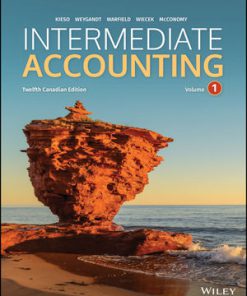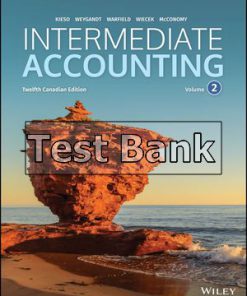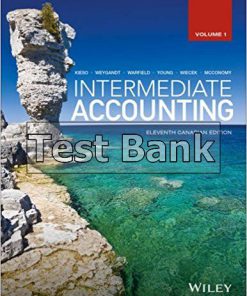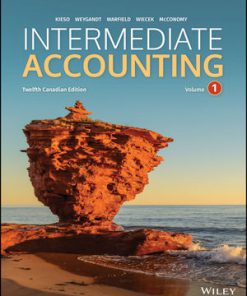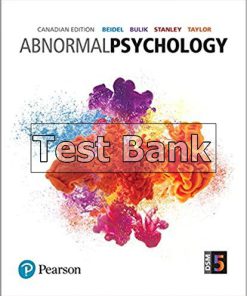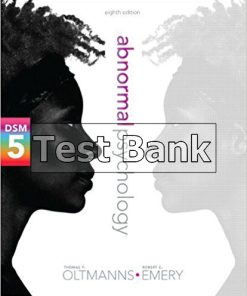Intermediate Accounting Volume 1 Canadian 10th Edition Kieso Test Bank
$26.50$50.00 (-47%)
Intermediate Accounting Volume 1 Canadian 10th Edition Kieso Test Bank.
You may also like
Intermediate Accounting Volume 1 Canadian 10th Edition Kieso Test Bank

Product details:
- ISBN-10 : 111830084X
- ISBN-13 : 978-1118300848
- Author: Donald E. Kieso, Jerry J. Weygandt, Terry D. Warfield, Nicola M. Young, Irene M. Wiecek, Bruce J. McConomy
The Kieso, Weygandt, Warfield, Young, Wiecek, McConomy: Intermediate Accounting text has an outstanding reputation as “THE” text for the course and is viewed as a reliable resource by accounting students, faculty and professionals. After listening carefully to instructors and students alike, and after having built on what we have learned over nine successful editions and more than 28 years of being the market leader, we are confident that the tenth edition will continue to meet the needs of instructors and students.
The integration of the new International Accounting Standards and their comparison with Accounting Standards for Private Enterprises enhances the main goal of the book, “to help students understand, prepare and use financial information by linking education with the ‘real-world’ accounting environment”. Our industry-experienced and leading-edge author expertise in the field of IFRS, combined with an update of the text’s technical content ensures that accounting faculty and students can continue to rely on Intermediate Accounting.
Table contents;
- CHAPTER 1 The Canadian Financial Reporting Environment
- FINANCIAL STATEMENTS AND FINANCIAL REPORTING
- Accounting and Capital Allocation
- Stakeholders
- Objective of Financial Reporting
- Information Asymmetry
- STANDARD SETTING
- Need for Standards
- Parties Involved in Standard Setting
- GENERALLY ACCEPTED ACCOUNTING PRINCIPLES
- GAAP Hierarchy
- Professional Judgement
- CHALLENGES AND OPPORTUNITIES FOR THE ACCOUNTING PROFESSION
- Oversight in the Capital Marketplace
- Centrality of Ethics
- Standard Setting in a Political Environment
- Principles versus Rules
- Impact of Technology
- Integrated Reporting
- Conclusion
- CHAPTER 2 Conceptual Framework Underlying Financial Reporting
- CONCEPTUAL FRAMEWORK
- Rationale for Conceptual Framework
- Development of the Conceptual Framework
- Information Asymmetry Revisited
- OBJECTIVE OF FINANCIAL REPORTING
- Qualitative Characteristics of Useful Information
- Elements of Financial Statements
- FOUNDATION PRINCIPLES
- Recognition/Derecognition
- Measurement
- Presentation and Disclosure
- FINANCIAL REPORTING ISSUES
- Principles-Based Approach
- Financial Engineering
- Fraudulent Financial Reporting
- IFRS/ASPE COMPARISON
- Looking Ahead
- APPENDIX 2A-FAIR VALUE MEASUREMENTS
- Income Models for Measuring Fair Value
- CHAPTER 3 The Accounting Information System
- ACCOUNTING INFORMATION SYSTEM
- Basic Terminology
- Debits and Credits
- Accounting Equation
- THE ACCOUNTING CYCLE AND THE RECORDING PROCESS
- Identifying and Recording Transactions and Other Events
- Journalizing
- Posting
- Trial Balance
- ADJUSTING ENTRIES
- Adjusting Entries for Prepayments
- Adjusting Entries for Accruals
- Adjusting Entries for Estimated Items
- Unrealized Holding Gains or Losses (NI and OCI)
- FINANCIAL STATEMENTS AND OWNERSHIP STRUCTURE
- THE CLOSING PROCESS
- Preparing Closing Entries
- Reversing Entries
- The Accounting Cycle Summarized
- USING A WORK SHEET
- Adjustments Entered on the Work Sheet
- Work Sheet Columns
- Preparing Financial Statements from a Work Sheet
- Closing Entries
- Monthly Statements, Yearly Closing
- APPENDIX 3A-USING REVERSING ENTRIES
- Illustration of Reversing Entries-Accruals
- Illustration of Reversing Entries-Prepayments
- Summary of Reversing Entries
- CHAPTER 4 Reporting Financial Performance
- PERFORMANCE
- Business Models and Industries
- Communicating Information about Performance
- Quality of Earnings/Information
- THE STATEMENT OF INCOME AND THE STATEMENT OF COMPREHENSIVE INCOME
- Measurement
- Discontinued Operations
- Presentation
- STATEMENT OF RETAINED EARNINGS AND THE STATEMENT OF CHANGES IN EQUITY
- Presentation of the Statement of Retained Earnings
- Presentation of the Statement of Changes in Equity
- DISCLOSURE AND ANALYSIS
- Disclosures
- Analysis
- IFRS/ASPE COMPARISON
- A Comparison of IFRS and ASPE
- Looking Ahead
- APPENDIX 4A-CASH BASIS VERSUS ACCRUAL BASIS EARNINGS
- Differences between Cash and Accrual Bases
- Conversion from Cash Basis to Accrual Basis
- Theoretical Weaknesses of the Cash Basis
- CHAPTER 5 Financial Position and Cash Flows
- USEFULNESS OF THE STATEMENTS OF FINANCIAL POSITION AND CASH FLOWS FROM A BUSINESS PERSPECTIVE
- Analyzing a Statement of Financial Position
- Assessing Earnings Quality
- Assessing the Creditworthiness of Companies
- STATEMENT OF FINANCIAL POSITION
- Usefulness of the Statement of Financial Position
- Limitations of the Statement of Financial Position
- Classification in the Statement of Financial Position
- Preparation of the Classified Statement of Financial Position (Balance Sheet)
- Additional Information Reported
- Techniques of Disclosure
- STATEMENT OF CASH FLOWS
- Purpose, Content, and Format of a Cash Flow Statement
- Preparation of the Statement of Cash Flows
- Usefulness of the Statement of Cash Flows
- Perspectives
- IFRS/ASPE COMPARISON
- A Comparison of IFRS and ASPE
- Looking Ahead
- APPENDIX 5A-RATIO ANALYSIS: A REFERENCE
- APPENDIX 5B-SPECIMEN FINANCIAL STATEMENTS
- Shoppers Drug Mart
- CUMULATIVE COVERAGE: CHAPTERS 3 TO 5
- CHAPTER 6 Revenue Recognition
- UNDERSTANDING THE NATURE OF SALES TRANSACTIONS FROM A BUSINESS PERSPECTIVE
- Economics of Business Transactions
- Legalities
- Information for Decision-Making
- RECOGNITION AND MEASUREMENT
- Earnings Process
- Measurability
- Collectibility
- Mechanics
- PRESENTATION AND DISCLOSURE
- Presentation
- Disclosure
- CONTRACT-BASED REVENUE RECOGNITION MODEL
- Core Principle
- Five Steps
- Other Issues Regarding the Contract-Based Approach
- IFRS/ASPE COMPARISON
- A Comparison of IFRS and ASPE
- Looking Ahead
- CHAPTER 7 Cash and Receivables
- UNDERSTANDING CASH AND ACCOUNTS RECEIVABLE
- How Do Companies Manage and Control Cash?
- What Types of Companies Have Extensive Accounts Receivable?
- Accounts Receivable Categories
- Accounts Receivable Planning and Control
- CASH RECOGNITION AND MEASUREMENT
- What Is Cash?
- Reporting Cash
- Summary of Cash-Related Items
- RECEIVABLES-RECOGNITION AND MEASUREMENT
- Definition and Types
- Recognition and Measurement of Accounts Receivable
- Impairment of Accounts Receivable
- Recognition and Measurement of Short-Term Notes and Loans Receivable
- Recognition and Measurement of Long-Term Notes and Loans Receivable
- Derecognition of Receivables
- PRESENTATION, DISCLOSURE, AND ANALYSIS OF RECEIVABLES
- Presentation and Disclosure
- Analysis
- IFRS/ASPE COMPARISON
- A Comparison of IFRS and ASPE
- Looking Ahead
- APPENDIX 7A-CASH CONTROLS
- Management and Control of Cash
- Using Bank Accounts
- The Imprest Petty Cash System
- Physical Protection of Cash Balances
- Reconciliation of Bank Balances
- CHAPTER 8 Inventory
- UNDERSTANDING INVENTORY
- What Types of Companies Have Inventory?
- Inventory Categories
- Inventory Planning and Control
- Information for Decision-Making
- RECOGNITION
- Accounting Definition
- Physical Goods Included in Inventory
- Inventory Errors
- MEASUREMENT
- Costs Included in Inventory
- Inventory Accounting Systems
- Cost Formulas
- Lower of Cost and Net Realizable Value
- Exceptions to Lower of Cost and Net Realizable Value Model
- Estimating Inventory
- PRESENTATION, DISCLOSURE, AND ANALYSIS
- Presentation and Disclosure of Inventories
- Analysis
- IFRS/ASPE COMPARISON
- A Comparison of IFRS and ASPE
- Looking Ahead
- APPENDIX 8A-THE RETAIL INVENTORYMETHOD OF ESTIMATING INVENTORY COST
- APPENDIX 8B- ACCOUNTING GUIDANCE FOR SPECIFIC INVENTORY
- CHAPTER 9 Investments
- UNDERSTANDING INVESTMENTS
- Types of Investments
- Types of Companies That Have Investments
- Information for Decision-Making
- MEASUREMENT
- Cost/Amortized Cost Model
- Fair Value through Net Income (FV-NI) Model
- Fair Value through Other Comprehensive Income (FV-OCI) Model
- Impairment Models
- STRATEGIC INVESTMENTS
- Investments in Associates
- Investments in Subsidiaries
- PRESENTATION, DISCLOSURE, AND ANALYSIS
- Presentation and Disclosure
- Analysis
- IFRS/ASPE Comparison
- A Comparison of IFRS and ASPE
- Looking Ahead
- CUMULATIVE COVERAGE: CHAPTERS 6 TO 9
- CHAPTER 10 Property, Plant, and Equipment: Accounting Model Basics
- THE IMPORTANCE OF PROPERTY, PLANT, AND EQUIPMENT FROM A BUSINESS PERSPECTIVE
- DEFINITION AND COST ELEMENTS
- Property, Plant, and Equipment Assets
- Recognition Principle
- Cost Elements
- MEASUREMENT OF COST
- Determining Asset Cost when Cash Is Not Exchanged at Acquisition
- Costs Associated with Specific Assets
- MEASUREMENT AFTER ACQUISITION
- Cost Model
- Revaluation Model
- Fair Value Model
- Costs Incurred after Acquisition
- IFRS/ASPE COMPARISON
- A Comparison of IFRS and ASPE
- Looking Ahead
- APPENDIX 10A-CAPITALIZATION OF BORROWING COSTS
- Qualifying Assets
- Capitalization Period
- Avoidable Borrowing Costs
- Disclosures
- APPENDIX 10B-REVALUATION: THE PROPORTIONATE METHOD
- CHAPTER 11 Depreciation, Impairment, and Disposition
- THE IMPORTANCE OF DEPRECIATION, IMPAIRMENT, AND DISPOSITION FROM A BUSINESS PERSPECTIVE
- DEPRECIATION-A METHOD OF ALLOCATION
- Factors Considered in the Depreciation Process
- Methods of Allocation (Depreciation)
- Depreciation-Methods of Calculation
- Depletion of Mineral Resources
- Other Depreciation Issues
- IMPAIRMENT
- Indicators of Impairment
- Impairment-Recognition and Measurement Models
- Asset Groups and Cash-Generating Units
- HELD FOR SALE AND DERECOGNITION
- Long-Lived Assets to Be Disposed of by Sale
- Derecognition
- PRESENTATION, DISCLOSURE, AND ANALYSIS
- Presentation and Disclosure
- Analysis
- IFRS/ASPE COMPARISON
- A Comparison of IFRS and ASPE
- Looking Ahead
- APPENDIX 11A-DEPRECIATION AND INCOME TAX
- Capital Cost Allowance Method
- CHAPTER 12 Intangible Assets and Goodwill
- THE IMPORTANCE OF INTANGIBLE ASSETS AND GOODWILL FROM A BUSINESS PERSPECTIVE
- DEFINITION, RECOGNITION, AND MEASUREMENT OF INTANGIBLE ASSETS
- Characteristics
- Recognition and Measurement at Acquisition
- Recognition and Measurement of Internally Developed Intangible Assets
- Recognition and Measurement after Acquisition
- Specific Intangibles
- IMPAIRMENT AND DERECOGNITION
- Impairment of Limited-Life Intangibles
- Impairment of Indefinite-Life Intangibles
- Derecognition
- GOODWILL
- Definition of Goodwill
- Recognition and Measurement of Goodwill
- Bargain Purchase
- Valuation after Acquisition
- Impairment of Goodwill
- PRESENTATION, DISCLOSURE, AND ANALYSIS
- Presentation and Disclosure
- Analysis
- IFRS/ASPE COMPARISON
- A Comparison of IFRS and ASPE
- Looking Ahead
- APPENDIX 12A-VALUING GOODWILL
- Excess-Earnings Approach
- Total-Earnings Approach
- Other Valuation Methods
- CUMULATIVE COVERAGE: CHAPTERS 10 TO 12
- Company Index
- Subject Index
- Glossary
People also search:
Intermediate accounting volume 1 canadian 10th
Intermediate accounting volume 1 13th canadian edition
Intermediate accounting volume 1 12th canadian edition solutions
Intermediate accounting volume 1 12th canadian edition
intermediate accounting volume 1 12th canadian edition pdf



